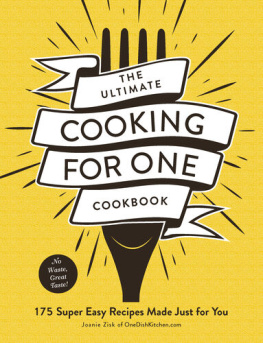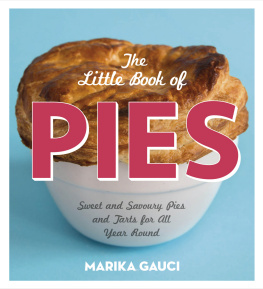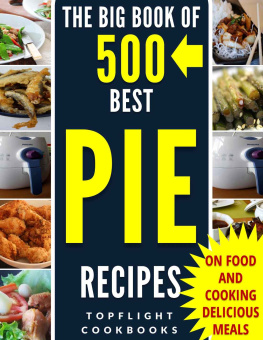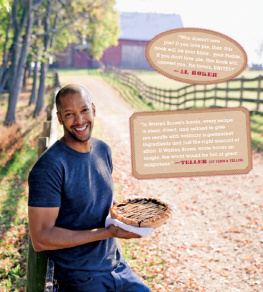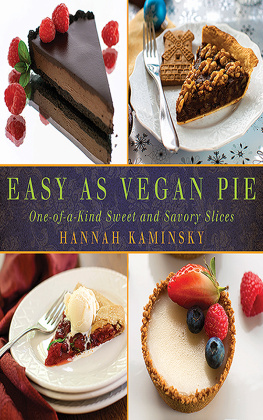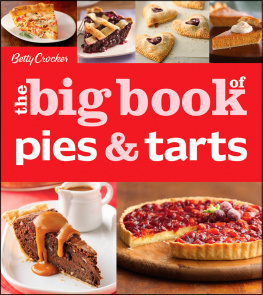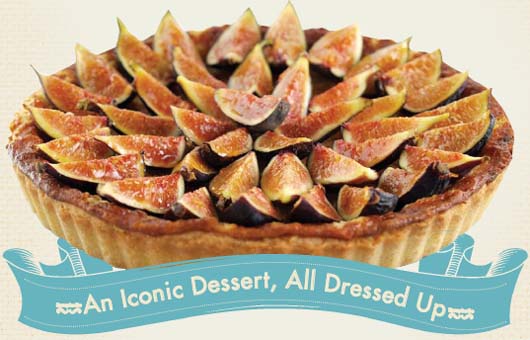First, I would like to thank my editors, Lisa and Katie, at Adams Media for all their support during this pie journey. You ladies have made this whole process easy, and I owe you both for making me look so good. Thank you for giving me a chance. I owe a tremendous debt to all the people who have taste-tested recipes for me. Thank you for your feedback, and for saving my waistline from all that pie. You are all troopers!
Special thanks go to my mother, Carol, for helping me when I was in a crunch for time by testing recipes. You have no idea how much that helped. I also need to thank my best friend, Jennifer, for your long-distance support. You may be across the pond, but you are always in my heart.
Finally, I want to thank my husband, Mark, for everything, but more specifically for his patience, understanding, and love.
INTRODUCTION
Pomegranate. Fresh figs. Sea salt.
Sounds delicious, right? These fresh ingredients are upscale, modern, and indulgentand theyre making an appearance in gourmet dishes across the world. But theyre also showing up in the most unexpected places, like the pie plate in your kitchen.
Pie. The word evokes images of home, comfort, family, and everything that is wholesome and good. But a pie is only as good as the ingredients used to make itand its time to say goodbye to grandmas humble apple, cherry, or blueberry baked goods. Todays bakers are experimenting with exciting flavors, textures, and fillings to create a new breed of pie that is as sophisticated as it is comforting. So say hello to the new generation of Not-So-Humble Pies.
These new pies come in all shapes and sizes, and can be sweet or savory. Throughout this book, youll find recipes that will tickle all of your taste budsand are right for any and all upscale occasions. But when considering ingredients, remember that quality counts. For fruits and vegetables, try shopping at the local farmers market, and discover whats in season where you live. Youll be amazed at the culinary treasures youll walk away with; these fresh ingredients can range from locally harvested honey and free-range eggs to fresh herbs, locally roasted coffee, fresh flowers, and even freshly butchered meats. And if youre looking for exotic spices, cheeses, or anything else out of the ordinary, take a look at the gourmet shops in your area. Not only will the staff in these stores take the time to show you around and explain what they sell, they will be able to direct you to substitutions or other ingredients you may not have considered. Do not be afraid to ask questions and use your senses.
But while what goes in a pie is important, how you present your pie to your guests, family, and friends is important, too. In Part 1, youll find recipes for upscale pie crusts and over-the-top toppings. You may not realize it, but you can take pie from homemade to high class with just a simple egg washa mixture of egg and a little waterwhich will give your pie a glistening finish, sanding sugars to make your pie sparkle, or fancy piping tubes that you can use to pipe detailed whipped cream or meringue designs. You can also play with chopped toasted nuts, fresh grated coconut, shaved chocolate, or even gold leaf, which you can use as a final flourish when you want a pie that is as pleasing to the eye as it is to the palate.
Above all else, pie is something to be shared and enjoyed, whether youre hosting a family dinner or a high-end function. Pie can be impressive or homey, but it shouldnt ever be boring. Take a chance, explore new flavors, experiment, and dont be afraid to let your pie take center stage. Because no matter how you choose to make it and share it, todays pie is anything but humble. Bon apptit!
PART 1
Not So Humble Beginnings

Buttery, flaky, and oh-so-tender, beautiful pies begin with beautiful crusts. Your filling can be made of sophisticated ingredients that are cooked to perfection, but if your crust is bland, tough, or soggy then it doesnt matter how good your filling is; your whole pie suffers. The same can be said of pie toppings; a weeping meringue, a grainy whipped cream, or a crumble that is mushy and watery are absolute disappointments.
Oftentimes, so much attention is paid to pie fillings that the very basics of the piethe base and the topsometimes get lost in the shuffle. But crust and toppings are so much more than just an afterthought. They are another place to layer in some extra flavor. Warm spices, crumbled cookies, and rich cheeses are just a few of the things you can add to a crust to up its extravagance. And when you top a pie off with a spiked whipped cream or a unique biscuit topping you create a not-so-humble pie that is impressive from top to bottom. In this part, youll find recipes for scrumptious crusts and delicious toppings that will make your pies even more amazing!
Chapter 1
Pastry and Cookie Crusts
The best foundation for a not-so-humble pie is a not-so-humble pie crust, which will help fill your pie with flavor from the bottom up. After all, most pies and tarts begin with the crust, and you want yours to be as upscale and unique as your carefully crafted fillings. In this chapter, youll learn how to bring the gourmet flavor profiles of lemon and lavender, cinnamon and chocolate, and parmesan and pepper jack into your crusts.
While the idea of making a good crust from scratch may seem intimidating (thus the proliferation of those ready-to-buy, refrigerated versions), whipping up the perfect pedestal for your pie is really quite easy. Remember to use a light touch, and work with your hands. Mix until the dough just begins to cling together and then knead it until it just comes together. After you make up the dough, cover it up and let it rest in your refrigerator for at least thirty minutes; this will relax the gluten and make rolling out much easier. Coat your work surface with a light but even dusting of flour and dont be afraid to add more flour as needed while rolling. If at any time your crust starts to snap back while rolling, chill it again. Giving your crustand yourselften minutes to cool off can make all the difference.
So, make your crust as upscale as the pie filling youll put in ityoull be glad you did.
Flaky Pie Crust
A perfectly tender and flaky pie crust is a thing of beauty. The flaky layers are created during baking when the water in the melting fat evaporates, causing steam. This steam expands and causes the crisp, flaky layers. Because of the delicate layers, flaky pie crusts are best used for the top of a pie, either as a full top crust or cut into strips and woven into a lattice crust.
YIELDS 1 (9) CRUST
1 cups all-purpose flour
2 tablespoons sugar
teaspoon salt
6 tablespoons butter, cubed and chilled
2 tablespoons lard or vegetable shortening, chilled
24 tablespoons ice water
In a large bowl, sift together the flour, sugar, and salt.
Add the chilled fats; rub them into the flour mixture with your fingers until 30 percent of the fat is between pea and hazelnut sized, while the rest is blended in well.

